I may be swimming against the current with a few of my tool post opinions, which were first expressed here:
http://www.metalworkingfun.com/showthrea...ol+holders
It’s worth noting that my usage may be different than most peoples’ and therefore my opinions are not useful. Nevertheless, in the interest of addressing the OP’s initial desire to accommodate both his 4-way and a QCTP system, here are a few thoughts, most are recycled from the above post.
I have two lathes (well, three if I include the only-used-once Chinese jeweler’s lathe). The small Emco Meier (which originally had a proprietary tool mounting system) is always equipped with a 4-way tool post. This little 8 inch lathe has always been extremely capable when removing a large amount of material quickly.
This is a photo showing a .250 depth of cut at .007 IPR in cold-rolled steel, to an accuracy better than .002 and with a good surface finish. That is absurdly aggressive for an 8 inch lathe but commonplace for this one. In fact the only complaint that I ever had with this machine was occasional chatter when parting. (But ten minutes work corrected even that small problem.)
 cut250.jpg (Size: 18.31 KB / Downloads: 104)
cut250.jpg (Size: 18.31 KB / Downloads: 104)
The second lathe, larger of the two is an 11 x 36 Sheldon with a Chinese knockoff QCTP and six or eight tool holders. This is the setup around 75% of the time. But I have two complaints about the QCTP system: relative lack of rigidity compared to some other types of tool holders and relative lack of versatility compared to some other types of tool holders.
I know, I know, that’s likely to stimulate a response like “Them’s fightin’ words, stranger” but let me try to talk my way out of this corner I’ve painted myself into. Let’s first note that a QCTP tool system (or a Multi-Fix) with a couple of exceptions, is probably the best choice for anyone making a number of similar parts, although a 4-way works OK for less repeatable operations.
Now, if one has no need to take heavy cuts or doesn’t do a lot of parting on a small lathe, no need to read further except for amusement/entertainment. The ten-minute-fix for the Emco-Meier mentioned above has turned out to be so useful that I’m surprised that others haven’t thought of and implemented it.
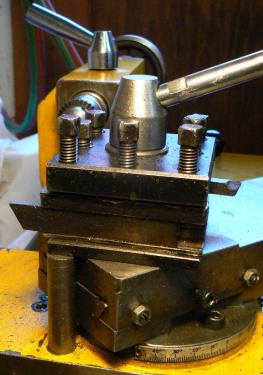
This is also described thoroughly in the link posted above. In short, it consists of a threaded post that sits directly under the right front corner of a 4-way, supporting the cutting tool just where it needs to be supported. The cutting load is directly transmitted to the cross-slide NOT through the compound and then to the cross-slide.
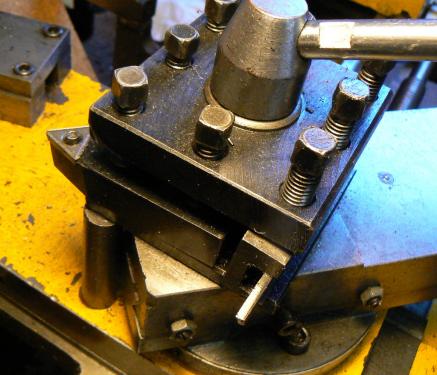
The top of the post is slotted so that it can be unthreaded from the cross slide, which has been tapped for the post. When the compound needs to be rotated or advanced further toward the work (only about 5% of the time in my case) the post is simply unscrewed and put aside.
In contrast, note how the cutting tool is positioned in a typical QCTP.
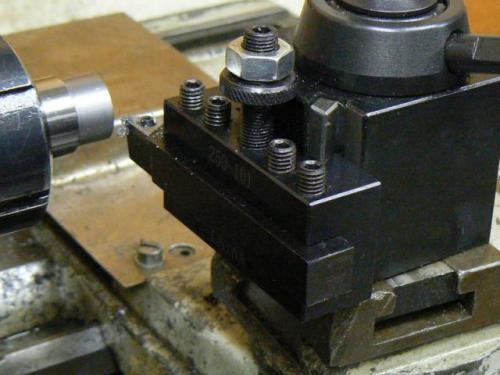
The cutting edge is hanging out in the air, cantilevered away from the mounting post by several inches and causing the cutting load to tilt the cross-slide. Conversely the modified 4-way applies the cutting load almost straight down, not only making it more rigid but (arguably) causing less wear on the cross-slide.
For most home machinists this may be of no consequence since there’s plenty of time to take shallow DOC and more passes. However it’s definitely an advantage for parting ! Naturally, the post modification isn't real practical for QCTP toolholders since they are adjusted to various heights.
As to the lack of versatility, I find this to be a disadvantage resulting in having to remove or rotate the QCTP about 15% of the time I use the lathe which is equipped with it, a Sheldon EXL-56P. This occurs in many of the following situations:
Again, time being of no issue for most of us, this may just be mice nuts. Also most of these disadvantages don't exist when doing typical chucking work (no tailstock center required). For some reason, about 30% of my work seems to be between centers. I guess I'm just lucky, LOL.
The 4-way tool post shares almost all of these disadvantages, obviously with the additional disadvantage of taking longer to set the cutting tool on center, although I’ve never found that to be a problem.
For example, in one of the above photos, a parting tool is shown in the 4-way installed in a shop-made holder. The holder is made so that the top of the parting tool is exactly centered on the work after sharpening – shims never required. One could argue that grinding chip breakers or positive rake would change the location of the cutting tip.
While this is true, it also has never been a problem in some thirty years of using this holder. Neutral rake accomodates mild steel, stainless, aluminum, copper-based alloys and all other materials I routinely use – plastics and wood not so well, however.
A ¼ square cutting tool is also visible which has a shop-made holder so that the cutting edge is always on center. The insert tool shown must be shimmed but only once. Inserts are replaced without removing the holder from the 4-way. There is one vacant station for whatever odd cutter is required. I don't use the 4-way for boring, there is a dedicated holder for that which can replace the 4-way in about ten seconds:
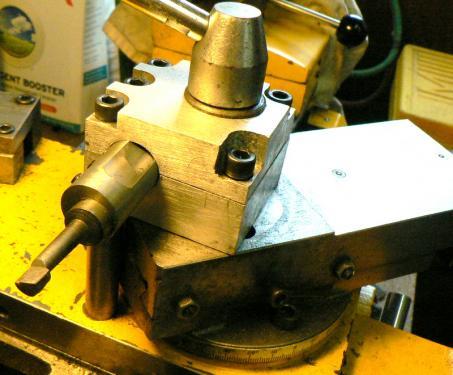
Regarding the disadvantages of the 4-way when changing the angle is required, long ago I worked around that problem by removing the indexing feature so that the 4-way is free to rotate to any angle. Like the QCTP, it must be reset after rotating so that the parting tool is perpendicular to the work. One loses the ability to return the cutting tool to a precise location but frankly, mine never did that anyway, LOL.
A wrongfully (in my opinion) maligned tool holding system is the Armstrong/Williams system used for many decades in this country and commonly known as the “lantern” tool post. It’s disadvantages are obvious, it’s advantages are not so obvious to those who haven’t used it. Using the typical angled tool holders, it is possible to “sneak” into awkward places that would be difficult, at best, if not impossible for the QCTP and the 4-way.
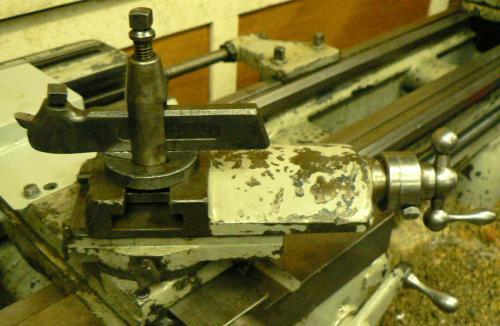
It is ideal for working with very short workpieces between centers and any operations where the working area is confined. A major disadvantage is the tool overhang, limiting the cutting load obtainable without chatter. In the above photo, the tool holder has been intentionally over-extended to emphasize the problem. An advantage all other systems (except rocker variants) lack is the ability to easily and quickly change cutting tool rake angle using the toolpost rocker.
By not using the forged toolholders and placing the cutting tool directly into the lantern, one achieves what may be (ignoring custom tool holders designed specifically for the task) the most rigid turning setup that can be configured quickly:
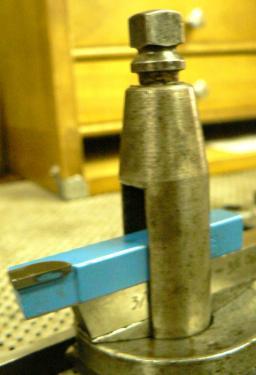
OK, these are a few thoughts regarding why there are often better alternatives than a QCTP. BUT remember the proviso made earlier that these thoughts apply to small lathes, of the type most often found in a home shop. (Not the machines belonging to some of our members over which I lose sleep from envy ! These monsters seem to be oblivious to the type of tool holding system employed.)
If someone were to ask "what is the best tool-holding method" my response would be "as many as you can afford and store" LOL. There will always be one situation in which one particular setup will obviously be the best. If for some reason I couldn't own a QCTP, it would be a toss-up between a 4-way and the lantern. 4-way for convenience and lantern system for versatility.
Many things mentioned above are broad generalities and need not apply in every situation or maybe not even in most. As an example, I recently parted off a few short 3 inch diameter lengths of hot-rolled steel with a QCTP and the parting tool hanging off 1.6 inches from the holder.
This was done on the 1945 Sheldon, a fairly sloppy machine from wear, as one would infer. Every movable part not required for the operation was locked and the cross-slide gibs were tightened. I did the parting in two steps, first with a stickout of about 1 inch and a speed of around 100 RPM and the remainder of the operation with the 1.6 inch stickout at around 250 RPM.
The feed was by hand and fairly aggressive with LOTS of sulphur pipe threading oil applied. It must be noted that I wouldn’t try this often on any lathe, I’d always prefer sawing the material but circumstances didn’t permit it this time. I was very, very careful (and very, very nervous).
In summary, if the OP comes up with a neat way to accommodate both of his tool-holding systems, I think he would have a seriously versatile setup, especially with a couple of simple modifications.
The preference and selection of a tool holder should be 90% based on the expectations of usage. Which - 95% of the time will be a QCTP (I'm one of the 95%) ! And, for the most part, price should not be part of the selection process, generally speaking. Buy a few holders at a time as needed.
Probably a large part of my fondness for the old-time tool holders is because that’s what I learned with. The shop classes I attended at San Jose State College (now University of California at San Jose) were set up with new-at-the-time South Bend “heavy tens” all with Dorian toolposts.
However the old Atlas in my garage had a lantern toolpost. Later, with the permission of my boss, I made a 4-way on my own time at the shop where I worked at night. (All of his engine lathes were equipped with 4-ways and I became accustomed to using them.)
(FWIW I found all of my Armstrong/Williams tool holders on eBay but I’ve noticed that prices are going up. Holders that I bought for less than $10 are now going for near $30 + shipping cost. That may be an indication that more folks are realizing how versatile these things can be.)
http://www.metalworkingfun.com/showthrea...ol+holders
It’s worth noting that my usage may be different than most peoples’ and therefore my opinions are not useful. Nevertheless, in the interest of addressing the OP’s initial desire to accommodate both his 4-way and a QCTP system, here are a few thoughts, most are recycled from the above post.
I have two lathes (well, three if I include the only-used-once Chinese jeweler’s lathe). The small Emco Meier (which originally had a proprietary tool mounting system) is always equipped with a 4-way tool post. This little 8 inch lathe has always been extremely capable when removing a large amount of material quickly.
This is a photo showing a .250 depth of cut at .007 IPR in cold-rolled steel, to an accuracy better than .002 and with a good surface finish. That is absurdly aggressive for an 8 inch lathe but commonplace for this one. In fact the only complaint that I ever had with this machine was occasional chatter when parting. (But ten minutes work corrected even that small problem.)
 cut250.jpg (Size: 18.31 KB / Downloads: 104)
cut250.jpg (Size: 18.31 KB / Downloads: 104)
The second lathe, larger of the two is an 11 x 36 Sheldon with a Chinese knockoff QCTP and six or eight tool holders. This is the setup around 75% of the time. But I have two complaints about the QCTP system: relative lack of rigidity compared to some other types of tool holders and relative lack of versatility compared to some other types of tool holders.
I know, I know, that’s likely to stimulate a response like “Them’s fightin’ words, stranger” but let me try to talk my way out of this corner I’ve painted myself into. Let’s first note that a QCTP tool system (or a Multi-Fix) with a couple of exceptions, is probably the best choice for anyone making a number of similar parts, although a 4-way works OK for less repeatable operations.
Now, if one has no need to take heavy cuts or doesn’t do a lot of parting on a small lathe, no need to read further except for amusement/entertainment. The ten-minute-fix for the Emco-Meier mentioned above has turned out to be so useful that I’m surprised that others haven’t thought of and implemented it.
This is also described thoroughly in the link posted above. In short, it consists of a threaded post that sits directly under the right front corner of a 4-way, supporting the cutting tool just where it needs to be supported. The cutting load is directly transmitted to the cross-slide NOT through the compound and then to the cross-slide.
The top of the post is slotted so that it can be unthreaded from the cross slide, which has been tapped for the post. When the compound needs to be rotated or advanced further toward the work (only about 5% of the time in my case) the post is simply unscrewed and put aside.
In contrast, note how the cutting tool is positioned in a typical QCTP.
The cutting edge is hanging out in the air, cantilevered away from the mounting post by several inches and causing the cutting load to tilt the cross-slide. Conversely the modified 4-way applies the cutting load almost straight down, not only making it more rigid but (arguably) causing less wear on the cross-slide.
For most home machinists this may be of no consequence since there’s plenty of time to take shallow DOC and more passes. However it’s definitely an advantage for parting ! Naturally, the post modification isn't real practical for QCTP toolholders since they are adjusted to various heights.
As to the lack of versatility, I find this to be a disadvantage resulting in having to remove or rotate the QCTP about 15% of the time I use the lathe which is equipped with it, a Sheldon EXL-56P. This occurs in many of the following situations:
- work is needed to be performed on the face of the tailstock end when turning between centers
- threading near the tailstock end (between centers)
- threading near the headstock ("dogleg" Armstrong holder much preferred)
- when rotating the compound for spherical turning
- when using the taper attachment and tapering near the tailstock (between centers)
- when the work is short, supported by tailstock and the working envelope is small
- other situations that unfailingly happen at the worst possible times
Again, time being of no issue for most of us, this may just be mice nuts. Also most of these disadvantages don't exist when doing typical chucking work (no tailstock center required). For some reason, about 30% of my work seems to be between centers. I guess I'm just lucky, LOL.
The 4-way tool post shares almost all of these disadvantages, obviously with the additional disadvantage of taking longer to set the cutting tool on center, although I’ve never found that to be a problem.
For example, in one of the above photos, a parting tool is shown in the 4-way installed in a shop-made holder. The holder is made so that the top of the parting tool is exactly centered on the work after sharpening – shims never required. One could argue that grinding chip breakers or positive rake would change the location of the cutting tip.
While this is true, it also has never been a problem in some thirty years of using this holder. Neutral rake accomodates mild steel, stainless, aluminum, copper-based alloys and all other materials I routinely use – plastics and wood not so well, however.
A ¼ square cutting tool is also visible which has a shop-made holder so that the cutting edge is always on center. The insert tool shown must be shimmed but only once. Inserts are replaced without removing the holder from the 4-way. There is one vacant station for whatever odd cutter is required. I don't use the 4-way for boring, there is a dedicated holder for that which can replace the 4-way in about ten seconds:
Regarding the disadvantages of the 4-way when changing the angle is required, long ago I worked around that problem by removing the indexing feature so that the 4-way is free to rotate to any angle. Like the QCTP, it must be reset after rotating so that the parting tool is perpendicular to the work. One loses the ability to return the cutting tool to a precise location but frankly, mine never did that anyway, LOL.
A wrongfully (in my opinion) maligned tool holding system is the Armstrong/Williams system used for many decades in this country and commonly known as the “lantern” tool post. It’s disadvantages are obvious, it’s advantages are not so obvious to those who haven’t used it. Using the typical angled tool holders, it is possible to “sneak” into awkward places that would be difficult, at best, if not impossible for the QCTP and the 4-way.
It is ideal for working with very short workpieces between centers and any operations where the working area is confined. A major disadvantage is the tool overhang, limiting the cutting load obtainable without chatter. In the above photo, the tool holder has been intentionally over-extended to emphasize the problem. An advantage all other systems (except rocker variants) lack is the ability to easily and quickly change cutting tool rake angle using the toolpost rocker.
By not using the forged toolholders and placing the cutting tool directly into the lantern, one achieves what may be (ignoring custom tool holders designed specifically for the task) the most rigid turning setup that can be configured quickly:
OK, these are a few thoughts regarding why there are often better alternatives than a QCTP. BUT remember the proviso made earlier that these thoughts apply to small lathes, of the type most often found in a home shop. (Not the machines belonging to some of our members over which I lose sleep from envy ! These monsters seem to be oblivious to the type of tool holding system employed.)
If someone were to ask "what is the best tool-holding method" my response would be "as many as you can afford and store" LOL. There will always be one situation in which one particular setup will obviously be the best. If for some reason I couldn't own a QCTP, it would be a toss-up between a 4-way and the lantern. 4-way for convenience and lantern system for versatility.
Many things mentioned above are broad generalities and need not apply in every situation or maybe not even in most. As an example, I recently parted off a few short 3 inch diameter lengths of hot-rolled steel with a QCTP and the parting tool hanging off 1.6 inches from the holder.
This was done on the 1945 Sheldon, a fairly sloppy machine from wear, as one would infer. Every movable part not required for the operation was locked and the cross-slide gibs were tightened. I did the parting in two steps, first with a stickout of about 1 inch and a speed of around 100 RPM and the remainder of the operation with the 1.6 inch stickout at around 250 RPM.
The feed was by hand and fairly aggressive with LOTS of sulphur pipe threading oil applied. It must be noted that I wouldn’t try this often on any lathe, I’d always prefer sawing the material but circumstances didn’t permit it this time. I was very, very careful (and very, very nervous).
In summary, if the OP comes up with a neat way to accommodate both of his tool-holding systems, I think he would have a seriously versatile setup, especially with a couple of simple modifications.
The preference and selection of a tool holder should be 90% based on the expectations of usage. Which - 95% of the time will be a QCTP (I'm one of the 95%) ! And, for the most part, price should not be part of the selection process, generally speaking. Buy a few holders at a time as needed.
Probably a large part of my fondness for the old-time tool holders is because that’s what I learned with. The shop classes I attended at San Jose State College (now University of California at San Jose) were set up with new-at-the-time South Bend “heavy tens” all with Dorian toolposts.
However the old Atlas in my garage had a lantern toolpost. Later, with the permission of my boss, I made a 4-way on my own time at the shop where I worked at night. (All of his engine lathes were equipped with 4-ways and I became accustomed to using them.)
(FWIW I found all of my Armstrong/Williams tool holders on eBay but I’ve noticed that prices are going up. Holders that I bought for less than $10 are now going for near $30 + shipping cost. That may be an indication that more folks are realizing how versatile these things can be.)




